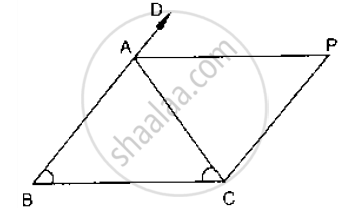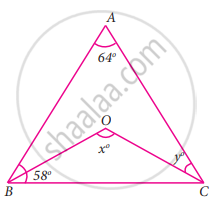Advertisements
Advertisements
प्रश्न
In a parallelogram ABCD, if ∠A = (3x − 20)°, ∠B = (y + 15)°, ∠C = (x + 40)°, then find the values of xand y.
उत्तर
In parallelogram ABCD, ∠A and ∠C are opposite angles.
We know that in a parallelogram, the opposite angles are equal.
Therefore,
∠C = ∠A
We have ∠A = (3x - 20°) and ∠C = (x + 40°)
Therefore,
x + 40° = 3x - 20°
x - 3x = -40° - 20°
-2x = - 60°
x = 30°
Therefore,
∠A = (3x - 20°)
∠A = [3(30) - 20°]
∠A = 70°
Similarly,
∠C = 70°
Also, ∠B = ( y + 15)°
Therefore,
∠D = ∠B
∠D = (y + 15 )°
By angle sum property of a quadrilateral, we have:
∠A + ∠B + ∠C + ∠D = 360°
70° +(y + 15)° + 70° + (y + 15)° = 360°
140° + 2 (y + 15)° = 360°
2(Y + 15)° = 360° - 140°
2(y + 15)° = 220°
(y + 15)° = 110°
y = 95°
Hence the required values for x and y are 30° and 95° respectively.
APPEARS IN
संबंधित प्रश्न
In a parallelogram ABCD, determine the sum of angles ∠C and ∠D .
The sides AB and CD of a parallelogram ABCD are bisected at E and F. Prove that EBFD is a parallelogram.
In Fig. below, AB = AC and CP || BA and AP is the bisector of exterior ∠CAD of ΔABC.
Prove that (i) ∠PAC = ∠BCA (ii) ABCP is a parallelogram

In a parallelogram ABCD, write the sum of angles A and B.
We get a rhombus by joining the mid-points of the sides of a
ABCD is a parallelogram in which diagonal AC bisects ∠BAD. If ∠BAC = 35°, then ∠ABC =
In a quadrilateral ABCD, ∠A + ∠C is 2 times ∠B + ∠D. If ∠A = 140° and ∠D = 60°, then ∠B=
In the given figure, ∠A = 64°, ∠ABC = 58°. If BO and CO are the bisectors of ∠ABC and ∠ACB respectively of ΔABC, find x° and y°
In the given Figure, if AB = 2, BC = 6, AE = 6, BF = 8, CE = 7, and CF = 7, compute the ratio of the area of quadrilateral ABDE to the area of ΔCDF. (Use congruent property of triangles)
Prove that the quadrilateral formed by the bisectors of the angles of a parallelogram is a rectangle.
